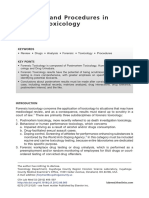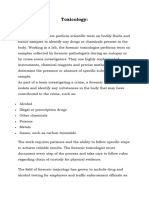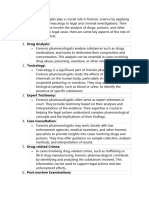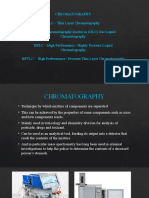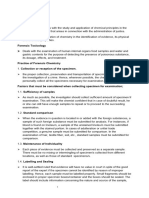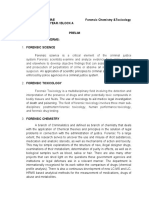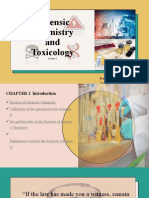Forensic Chemistry Is The Application of
Forensic Chemistry Is The Application of
Uploaded by
Priya SharmaOriginal Title
Copyright
Available Formats
Share this document
Did you find this document useful?
Is this content inappropriate?
Report this DocumentCopyright:
Available Formats
Forensic Chemistry Is The Application of
Forensic Chemistry Is The Application of
Uploaded by
Priya SharmaCopyright:
Available Formats
Forensic chemistry is the application of chemistry and its subfield, forensic toxicology, in a legal
setting. A forensic chemist can assist in the identification of unknown materials found at a crime
scene.[1] Specialists in this field have a wide array of methods and instruments to help identify
unknown substances. These include high-performance liquid chromatography, gas chromatography-
mass spectrometry, atomic absorption spectroscopy, Fourier transform infrared spectroscopy,
and thin layer chromatography. The range of different methods is important due to the destructive
nature of some instruments and the number of possible unknown substances that can be found at a
scene. Forensic chemists prefer using nondestructive methods first, to preserve evidence and to
determine which destructive methods will produce the best results.
Along with other forensic specialists, forensic chemists commonly testify in court as expert
witnesses regarding their findings. Forensic chemists follow a set of standards that have been
proposed by various agencies and governing bodies, including the Scientific Working Group on the
Analysis of Seized Drugs. In addition to the standard operating proceduresproposed by the group,
specific agencies have their own standards regarding the quality assurance and quality control of
their results and their instruments. To ensure the accuracy of what they are reporting, forensic
chemists routinely check and verify that their instruments are working correctly and are still able to
detect and measure various quantities of different substances.
You might also like
- Module 1 Forensic Chemistry and ToxicologyDocument40 pagesModule 1 Forensic Chemistry and ToxicologyPigsy90% (21)
- 5.4 Drug Test Methods 02-10-12Document162 pages5.4 Drug Test Methods 02-10-12Maxo PardieuNoch keine Bewertungen
- Simplified Guide Drug ChemistryDocument23 pagesSimplified Guide Drug ChemistrybobNoch keine Bewertungen
- Reviewer in ChemDocument97 pagesReviewer in ChemMichael QuidorNoch keine Bewertungen
- Role in Investigations: Chapter 1: Introduction To Forensic Chemistry & ToxicologyDocument8 pagesRole in Investigations: Chapter 1: Introduction To Forensic Chemistry & ToxicologyJulia MaayoNoch keine Bewertungen
- Chapter 1 Intro Forensic Chem 1Document38 pagesChapter 1 Intro Forensic Chem 1garciamabettinaNoch keine Bewertungen
- Forensic ResearchDocument2 pagesForensic ResearchMaria SisonNoch keine Bewertungen
- Forensic ChemistryDocument11 pagesForensic ChemistryBEST OF ONE PIECE100% (1)
- 4729 Et 4729 Et 01etDocument7 pages4729 Et 4729 Et 01etAushnik RoyNoch keine Bewertungen
- What Is Forensic ToxicologyDocument7 pagesWhat Is Forensic ToxicologyMurali G RaoNoch keine Bewertungen
- Clinics in Laboratory MedicineDocument15 pagesClinics in Laboratory MedicineMárcio RodriguesNoch keine Bewertungen
- Role of Forensic ChemistryDocument11 pagesRole of Forensic ChemistryBEST OF ONE PIECE100% (1)
- ToxicologyDocument13 pagesToxicologyRiya GuptaNoch keine Bewertungen
- DocumentDocument36 pagesDocumentShikhar SinghNoch keine Bewertungen
- Role of Forensic PharmacologistsDocument2 pagesRole of Forensic Pharmacologistsgulfamahmad1199786Noch keine Bewertungen
- Forensic Chemistry: Kimberly Mae MirantesDocument25 pagesForensic Chemistry: Kimberly Mae MirantesBEST OF ONE PIECENoch keine Bewertungen
- Analytical ChemistryDocument14 pagesAnalytical ChemistryHadi HussainNoch keine Bewertungen
- FORENSIC CHEMISTRY AND TOXICOLOGY DiscussionDocument35 pagesFORENSIC CHEMISTRY AND TOXICOLOGY DiscussionNemcris Mae OpleNoch keine Bewertungen
- Manuscript Forensic Chemistry 7Document42 pagesManuscript Forensic Chemistry 7kathleenNoch keine Bewertungen
- Chemicals and Chemical Processes in Forensic Studies-Isc Chemistry ProjectDocument10 pagesChemicals and Chemical Processes in Forensic Studies-Isc Chemistry ProjectihuhiNoch keine Bewertungen
- Forensic ChemistryDocument3 pagesForensic ChemistryTherese BaldosNoch keine Bewertungen
- ToxiDocument151 pagesToxikarl luis100% (2)
- Forensic ToxicologistDocument17 pagesForensic ToxicologistKirsten DoucetteNoch keine Bewertungen
- Toksikologi Laboratory Report-2Document7 pagesToksikologi Laboratory Report-2Luka DaNoch keine Bewertungen
- Crim Presentation 2Document23 pagesCrim Presentation 2NyyokieCarrNoch keine Bewertungen
- Chemistry Project WorkDocument24 pagesChemistry Project Workarchanasinghrajput2024Noch keine Bewertungen
- Prepared By: Group 4: Lourdelyn S. Olivar Carlo Medina Hanna Rhea Nuńala Fernando MontemayorDocument60 pagesPrepared By: Group 4: Lourdelyn S. Olivar Carlo Medina Hanna Rhea Nuńala Fernando MontemayorAling Lulu100% (1)
- FORENSIC CHEMISTRY IntroductionDocument2 pagesFORENSIC CHEMISTRY IntroductionTrisha Mae Kitong100% (1)
- Forensic Chemist IIDocument5 pagesForensic Chemist IIMSKNoch keine Bewertungen
- FORENSICSDocument11 pagesFORENSICSAmbika Kobayashi KrishnapillaiNoch keine Bewertungen
- Forensic ToxicologyDocument7 pagesForensic ToxicologyLaiba Jahangir100% (2)
- Forensic Chemistry CourseDocument292 pagesForensic Chemistry CourseLurthu PushparajNoch keine Bewertungen
- Forensic ChemistryDocument3 pagesForensic ChemistryDan NavarroNoch keine Bewertungen
- CocaDocument214 pagesCocaMark Joseph C. PanchitaNoch keine Bewertungen
- Instrumentation - G5Document21 pagesInstrumentation - G5Jason CorderoNoch keine Bewertungen
- Week 3 - Forensic PDFDocument1 pageWeek 3 - Forensic PDFShirsendu MondolNoch keine Bewertungen
- FR SC 103Document11 pagesFR SC 103Shaina Mae CaminocNoch keine Bewertungen
- Maurer-2006-Journal of Mass SpectrometryDocument15 pagesMaurer-2006-Journal of Mass SpectrometryMarceloNoch keine Bewertungen
- Brief IntroDocument6 pagesBrief IntroJames Van Arquero NaronNoch keine Bewertungen
- Forensic LU1 2014Document55 pagesForensic LU1 2014Noorashikin JohariNoch keine Bewertungen
- New Cur Forensic Chemistry and ToxicologyDocument77 pagesNew Cur Forensic Chemistry and ToxicologyJeaniel Joy Babol BS CRIMNoch keine Bewertungen
- Che ProjectDocument13 pagesChe ProjectTanmay GagnejaNoch keine Bewertungen
- Forensic Drug AnalysisDocument6 pagesForensic Drug AnalysisIJRASETPublicationsNoch keine Bewertungen
- ToxicologyDocument7 pagesToxicologyriyaNoch keine Bewertungen
- Chemistry Project Work - CompressDocument24 pagesChemistry Project Work - CompressAryan ShahNoch keine Bewertungen
- Forum - FRSC3-18 - Assignment - Jerome T. Figuracion - CCR 3 - B1Document2 pagesForum - FRSC3-18 - Assignment - Jerome T. Figuracion - CCR 3 - B1Gis ELNoch keine Bewertungen
- Forensic Instrumentation HandoutsDocument25 pagesForensic Instrumentation HandoutsJhu-dhy Anne ChilaganNoch keine Bewertungen
- Forensic PharmacyDocument4 pagesForensic PharmacyNajeebNoch keine Bewertungen
- Chapter - 4 ToxicologyDocument37 pagesChapter - 4 ToxicologyTemesgen FisehaNoch keine Bewertungen
- For Chem Chapter 1 5Document8 pagesFor Chem Chapter 1 5caseycooperkp22Noch keine Bewertungen
- FCT Module 1Document32 pagesFCT Module 1Jhendee 10Noch keine Bewertungen
- Forensic 3 3Document19 pagesForensic 3 3argiebutchconcha0715Noch keine Bewertungen
- Boholst, Jewerly Mae Forensic Chemistry &toxicology B.S Criminology 3 Year / Block ADocument8 pagesBoholst, Jewerly Mae Forensic Chemistry &toxicology B.S Criminology 3 Year / Block AJewerly BoholstNoch keine Bewertungen
- Forum - FRSC3-18 - Assignment - Jerome T. Figuracion - CCR 3 - B1Document2 pagesForum - FRSC3-18 - Assignment - Jerome T. Figuracion - CCR 3 - B1Gis ELNoch keine Bewertungen
- 15 Safe Handling of Carcinogenic Teratogenic and Mutagenic Compounds CCTMDocument19 pages15 Safe Handling of Carcinogenic Teratogenic and Mutagenic Compounds CCTMhyde2520015754Noch keine Bewertungen
- Criminal Is TicsDocument5 pagesCriminal Is TicsJonirie DollenteNoch keine Bewertungen
- FC 106 (Lecture 1)Document26 pagesFC 106 (Lecture 1)Johnpatrick DejesusNoch keine Bewertungen
- Forensic 3 FORENSIC CHEMISTRY AND TOXICOLOGY BY CLBN NAVILLADocument19 pagesForensic 3 FORENSIC CHEMISTRY AND TOXICOLOGY BY CLBN NAVILLASheildonn John Abarca100% (1)
- Analytical Chemistry Techniques for Detecting and Measuring Substances.From EverandAnalytical Chemistry Techniques for Detecting and Measuring Substances.Noch keine Bewertungen










